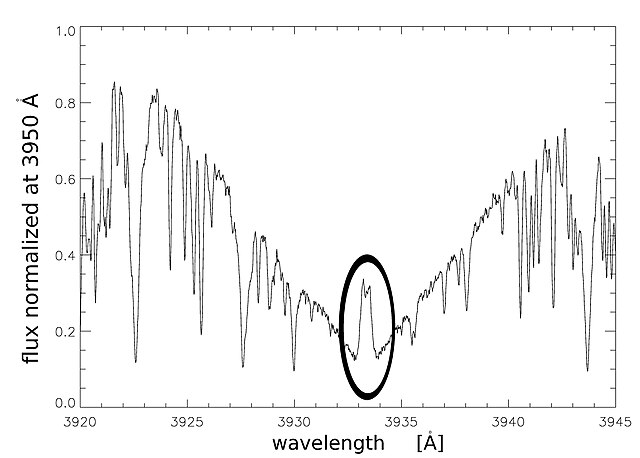PHENOMENON
Decoding the Enigma of the Wilson-Bappu Effect in Stellar Phenomena
Written By: Syeda Natasha hassan
Jan 22nd, 2024
Have you ever gazed at the nighttime sky, mesmerized by the twinkling tapestry of stars above? Each distant sun holds secrets within its luminous embrace, including the enigmatic Wilson-Bappu effect, a celestial whisper hinting at the complex dance of stellar evolution. Imagine holding a cosmic ruler, measuring the light pouring from stars. Astronomers have discovered a curious connection: the width of a specific line in a star's spectrum, like a fingerprint of its fiery breath, appears to reveal the secret of its brightness. This phenomenon, unveiled by astronomers Olin C. Wilson and Vainu Bappu in 1957, is the Wilson-Bappu effect.
Understanding the Wilson-Bappu effect is like deciphering a hidden language in starlight. It allows us to peek into the hearts of stars, gauging their luminosity—a crucial clue to their age, mass, and ultimately, their fate. In the grand saga of stellar evolution, where stars are born, blaze with brilliance, and fade into cosmic embers, the Wilson-Bappu effect gives a treasured glimpse into the unfolding chapters.
Historical Background
In 1957, amidst the excitement of Sputnik's orbit and the dawn of the Space Age, astronomers Olin Chaddock Wilson and M.K.V. Bappu made a discovery that would illuminate our understanding of stars: the Wilson-Bappu effect. At the heart of their discovery lies a specific line in a star's spectrum called the Ca II K line. This line, originating in the star's chromosphere, a fiery layer surrounding its surface, held the key to unlocking a hidden relationship.

In this image, Vainu Bappu, the visionary Indian astronomer, is captured in a moment of scientific contemplation. His focused expression reflects a deep commitment to unraveling the mysteries of the cosmos, symbolizing his impactful contributions to the field of astronomy.
Bappu, a young Indian astronomer on a Fulbright scholarship, was analyzing stellar spectra at Mount Wilson Observatory in California. He noticed variations in the width of the Ca II K line, seemingly related to the brightness of the stars he observed. Wilson, an experienced astronomer, recognized the potential significance of Bappu's observations. Together, they embarked on a series of meticulous studies, comparing the spectra of numerous stars and measuring the width of the Ca II K line.
Cracking the Code of Starlight
The Wilson-Bappu effect unveils itself as a celestial whisper, gently offering tantalizing clues into the intricate narratives of distant suns. This cosmic phenomenon is akin to an enigmatic detective story inscribed in the very fabric of starlight, patiently awaiting the deciphering hands of astronomers and curious minds. Within the vast cosmic theater, stars possess unique "fingerprints" known as spectra, divulging essential details about their composition and activity. A pivotal element within these spectral fingerprints is the Ca II K line, originating in the fiery outer layer known as the chromosphere. It is within this faint line that the Wilson-Bappu effect resides, holding the cosmic key to unlocking the secrets concealed within the luminous tapestry of the universe.
The Wilson-Bappu effect, like a celestial detective, reveals an intriguing correlation: the broader the Ca II K line in a star's spectrum, the more radiant the star itself becomes. Picture this relationship as a cosmic whisper – a broad, faint whisper indicating a colossal star, while a narrow, hushed whisper alludes to a more modest, diminutive celestial body. This connection between the width of the Ca II K line and a star's brightness emerges as a potent tool for astronomers. As they meticulously measure the width of this spectral line in distant stars, even when conventional methods falter, they gain insights into the star's luminosity. This luminosity, in turn, unravels the star's age, mass, and its place within the cosmic ballet of stellar existence.

In this image, the K line spectrum of KW 326, a dwarf star in the Praesepe open cluster, reveals a broad and deep line in the photosphere. Overlaying lines contribute to the complexity, with central emission from the K line occurring in the chromosphere, unveiling intricate stellar dynamics.
The Wilson-Bappu effect assumes the role of a cosmic decoder ring, facilitating the translation of ethereal whispers of starlight into gripping stories of stellar evolution. Armed with this celestial tool, astronomers navigate the expansive narrative of stellar birth, life, and eventual demise. In the meticulous examination of stellar spectra, the width of the distinctive Ca II K line emerges as a crucial metric. Through this measurement, the Wilson-Bappu effect empowers astronomers to estimate the luminosity of stars, offering a vital clue to their age and stage of life. The cosmic stage becomes a chronicle as brighter stars tell tales of youth, while dimmer ones whisper narratives of their ancient past.
"The Wilson-Bappu effect: where starlight becomes a language, and the Ca II K line, a storyteller revealing the ages and tales of celestial bodies."
Expanding the scope to include star clusters and galaxies, the Wilson-Bappu effect becomes an astronomical age calculator. Peering into the cosmic photo album, astronomers trace the birth and evolution of galaxies over the vast expanse of billions of years, narrated through the subtle variations in the Ca II K lines of numerous stars within these celestial conglomerates. As stars progress through their evolutionary journey from hot, brilliant main sequence stars to cooler, dimmer red giants, the Wilson-Bappu effect paints a vivid portrait of this stellar metamorphosis. The widening of the Ca II K line serves as a visual symphony, capturing the dynamic transformations within these celestial bodies.
The Wilson-Bappu effect, though just a single note, harmonizes seamlessly within the grand symphony of stellar evolution. Collaborating with other astronomical tools such as stellar models and observations of star clusters, astronomers weave together a more intricate and comprehensive understanding of how stars pirouette through their life cycles, ultimately shaping the galaxies that cradle them.
Conclusion
This cosmic whisper, the Wilson-Bappu effect, continues to captivate astronomers, beckoning them to explore the universe with an ever-growing sense of wonder. Recent advancements in research push the boundaries of this cosmic phenomenon, promising to unveil even more enthralling discoveries in the ongoing quest to unravel the secrets of the stars. So, the next time you find yourself staring into the star-studded night sky, remember that the seemingly silent points of light are not mere luminous specks. They are whispers, patiently waiting to be heard, and the Wilson-Bappu effect is our key to deciphering the secrets they hold—secrets that illuminate the very story of our universe.
"Olin C. Wilson and Vainu Bappu gifted us the Wilson-Bappu effect, a stellar symphony playing out in the subtle whispers of starlight."
Subscribe To Our Newsletter
Receive amazing space news and stories that are hot off the press and ready to be read by thousands of people all around the world.
